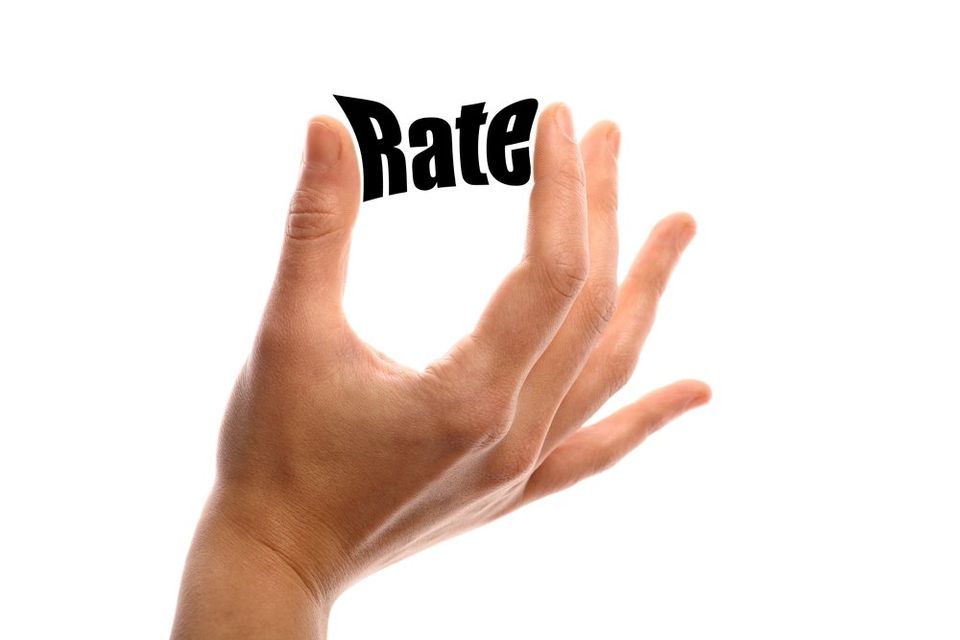It's NOT All About The Rate
Michael Hallett • June 22, 2015

ob-sess(ed):
the act of being preoccupied or fill the mind continually, intrusively and to a troubling extend.
As mortgage consumers we get obsessed with obtaining best rate, we caught in the cross-hairs of lender marketing. Lenders spends millions of dollars annually to pitch their message; some listen and some don't. As consumers we all want make sure we are getting the best value for our money. When entering into the world of purchase and owning real estate, there should be a detailed plan laid out for one to follow. We should make sure all our plans fit the mortgage products we inherently rely on. Would you put a square peg in a round hole?
Along with making sure the mortgage product is suitable there is also an element of competition between friends, family members and even colleagues at work. Consumers thought process goes something like this (...and I was once part of this faculty)..."I need to get the lowest rate so that I supersede the rate that (enter name here) got..." That statement couldn't be further from the true, it's 100% wrong.
We all want to pay as little as possible up front, but never put any thought into life's uncertainties. What if you need to break the mortgage?; to consolidate some debt, require equity for a renovation, moving to another town/city where your current lender does lend, leverage equity to take advantage of some financial planning strategies...the list goes on.
60% or 6 out of every 10 mortgages that originally opt for a 5 year fixed term are changed/broken/altered 38 months into the contract. The act of breaking ones mortgage will yield a penalty on the outstanding balance for 22 months. The penalty will be either an Interest Rate Differential calculation or 3 month interest, whatever is greater. There is so much more to choosing a mortgage rate and term than just the 5 bold characters ?.??% being advertised.
Borrower's have to look past the numbers and educate themselves on the terms of that rate being offered; the fine print!
Depending on the RATE and its terms that penalty can be dramatically different. Lenders all have a suite of various products to fit your the consumers wants and needs. It's up to you and your Mortgage Expert to navigate through the gauntlet of rate sheets and product information to find what works for you and your specific scenario. As Mortgage Experts we have access to a wide range of lenders; major chartered banks, credit unions and investment lenders. At times there could be a difference of 10 to 20 basis point (0.10-0.20%) from lender to lender.
Let's take for example a rate of 2.44% vs 2.64% for a 5 year fixed term. It's obvious which one most borrowers would gravitate to, but is it worth it? What are the pitfalls? These two rates have drastically different penalty structures even though they are offered by the same lender. The 2.44% rate holds a 3% penalty on the outstanding mortgage balance (OSB). The 2.64% rate calculates the Interest Rate Differential (IRD) or 3 months interest, whatever is greater to determine the penalty.
Here is an example of what it would cost to exit these mortgage contracts early. We will use the 60% rule along with a starting balance of $330,000, 25 year amortization and $0 prepayments made to the principal for the first 38 months.
Rate 2.44% 2.64%
OSB @ 38 mos $298,401.05 $299,153.80
Penalty 8,952.03 $2,468.02
Difference $6,484.01
Monthly payment $1,468.45 $1,501.39
Difference over 38 mos $1,251.72
Same term but different mortgage product yields a difference in penalty of $6,484.01. Over that same 38 month term the higher interest will have an 'out-of-pocket' difference of $1,251.72. Now ask yourself, with all of life's uncertainties which would you prefer the 2.44% or 2.64% rate. I would choose the higher rate and pay $5,232.29 less.
This is where having a knowledgeable Mortgage Expert working for you pays off in spades. They will review your plan and recommend the best mortgage product. Make sure you examine all aspects of the mortgage, 60% of 5 year fixed mortgages are altered. Here's yet another reason to always consider variable rate mortgages, much more flexible and only yield 3 month interest penalty on the OSB no matter where you are in the contract timeline.
If you are looking for personalized mortgage advice, contact me anytime!
SHARE
MY INSTAGRAM
Mortgage Brokering meets mountain biking and craft beer. A couple months ago I set for a bike ride with the intention of answering few mortgage related questions, mission accomplished. Any good bike ride pairs nicely with a tasty beer which we enjoyed @parksidebrewery. Hope you see the passion I have for brokering, biking and beer. @torcabikes #mountainbikingmortgagebroker
TEASER alert...at thats what I think they call it in the business. Years ago a wrote a blog called BEERS BIKES AND MORTGAGES. I some how (in my head) blended all 3 topics into 1 blog. Simply put, I enjoy aspects of all 3 with each of them providing something different. I re-united with the talented Regan Payne on a project that I think will shed a bit more light on who I am and what I do. #craftbeer #mountainbike #mortgagebrokerbc #dlccanadainc
I saw this hat on Instagram, that very moment I knew I needed it. As a BC boy born and bred The Outdoorsman hat needed to be added to my collection. As someone who loves BC and most things outdoor, I’m now glad I have a cool hat to wear and fly the flag of BEAUTIFUL BRITISH COLUMBIA. It will be in my bag for all post-exploration celebratory cold pints. If you want to check them out or add one to your collection go to @nineoclockgun ...and yes my facial hair matches the hat as well.
View more

Bank of Canada maintains policy rate at 2.1/4%. FOR IMMEDIATE RELEASE Media Relations Ottawa, Ontario December 10, 2025 The Bank of Canada today held its target for the overnight rate at 2.25%, with the Bank Rate at 2.5% and the deposit rate at 2.20%. Major economies around the world continue to show resilience to US trade protectionism, but uncertainty is still high. In the United States, economic growth is being supported by strong consumption and a surge in AI investment. The US government shutdown caused volatility in quarterly growth and delayed the release of some key economic data. Tariffs are causing some upward pressure on US inflation. In the euro area, economic growth has been stronger than expected, with the services sector showing particular resilience. In China, soft domestic demand, including more weakness in the housing market, is weighing on growth. Global financial conditions, oil prices, and the Canadian dollar are all roughly unchanged since the Bank’s October Monetary Policy Report (MPR). Canada’s economy grew by a surprisingly strong 2.6% in the third quarter, even as final domestic demand was flat. The increase in GDP largely reflected volatility in trade. The Bank expects final domestic demand will grow in the fourth quarter, but with an anticipated decline in net exports, GDP will likely be weak. Growth is forecast to pick up in 2026, although uncertainty remains high and large swings in trade may continue to cause quarterly volatility. Canada’s labour market is showing some signs of improvement. Employment has shown solid gains in the past three months and the unemployment rate declined to 6.5% in November. Nevertheless, job markets in trade-sensitive sectors remain weak and economy-wide hiring intentions continue to be subdued. CPI inflation slowed to 2.2% in October, as gasoline prices fell and food prices rose more slowly. CPI inflation has been close to the 2% target for more than a year, while measures of core inflation remain in the range of 2½% to 3%. The Bank assesses that underlying inflation is still around 2½%. In the near term, CPI inflation is likely to be higher due to the effects of last year’s GST/HST holiday on the prices of some goods and services. Looking through this choppiness, the Bank expects ongoing economic slack to roughly offset cost pressures associated with the reconfiguration of trade, keeping CPI inflation close to the 2% target. If inflation and economic activity evolve broadly in line with the October projection, Governing Council sees the current policy rate at about the right level to keep inflation close to 2% while helping the economy through this period of structural adjustment. Uncertainty remains elevated. If the outlook changes, we are prepared to respond. The Bank is focused on ensuring that Canadians continue to have confidence in price stability through this period of global upheaval. Information note The next scheduled date for announcing the overnight rate target is January 28, 2026. The Bank’s next MPR will be released at the same time.

Following several challenging years, British Columbia’s housing market is beginning to stabilize. Prices, which experienced downward pressure in 2024–2025, have largely plateaued, with some areas showing modest gains. The recent Bank of Canada rate reduction to 2.25% has lowered borrowing costs, improving affordability and supporting market activity. Across the province, housing supply is gradually increasing. Builders are delivering more condos, townhomes, and single-family homes, easing some supply constraints. Meanwhile, population growth, fueled by domestic migration and international immigration, continues to support long-term housing demand. Key Statistics Home sales: BC home sales declined slightly in 2025 by approximately 1.1% to 73,650 units but are projected to rebound in 2026 by around 8.8%, reaching roughly 80,150 units. Average home price: The provincial average price dipped modestly by 0.9% in 2025 to $972,800, with forecasts projecting an increase of 3.2% in 2026 to approximately $1,004,000. Benchmark home price: As of April 2025, the BC benchmark home price stood at $953,500, down 1.3% year-over-year. Listings and inventory: Active listings are expected to exceed 40,000 units in 2025, the highest in more than a decade. Market Forecast 2025: Market remains relatively flat, with modest declines in sales and prices. 2026: Sales and prices begin to recover, with modest upward trends. Early 2027: Market stabilizes, reflecting measured growth and improved affordability. Regional differences will continue. Urban condo markets may see slower price appreciation, while suburban and smaller communities with limited supply could experience stronger gains. What This Means for Buyers and Homeowners Prospective buyers: 2026 is an opportunity to enter a more balanced market with lower interest rates. Current homeowners: Refinancing or mortgage renewal could be advantageous in this period of slightly lower rates. Investors: Localized analysis is critical, as neighborhood inventory and rental demand will determine returns. Bottom Line: BC’s housing market is shifting from a cooling phase toward a period of gradual recovery. Lower interest rates, steady population growth, and increased housing supply point to a healthier, more sustainable market. Buyers, homeowners, and investors should plan strategically, recognizing that while growth is returning, the pace will be measured and regionally variable.










































































































